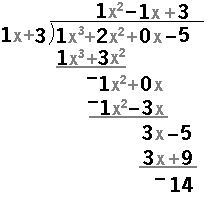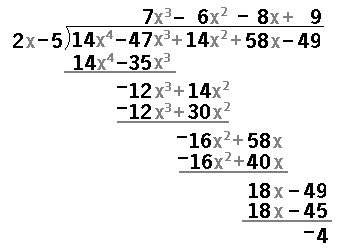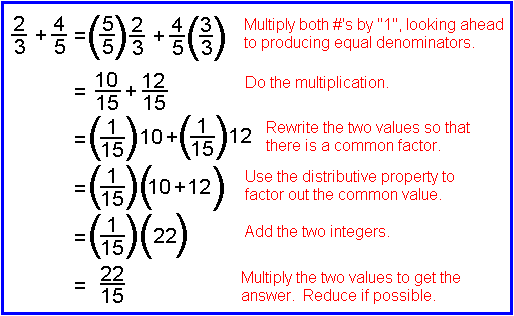General NOTES for Math 169
Fifth Edition
Chapter 6
Introduction to Detailed Notes
This is a set of notes that have been made on reading the textbook. There
is no real attempt to have comments on absolutely everything in the
book noted here. At the same time, there is supplementary material here that
is not in the book.
After writing out the notes for the first few sections, it has become clear that
there is a tendency to make this a "teaching" document. As much as possible,
efforts will be made to not do this. Rather, if there is teaching material
to be presented then that will be done in separate pages, with pointers inserted here.
Chapter 6: Rational Expressions
6.1 Reducing Rational Roots
Page 336: I find the notation in box #2 at the bottom of the page to be unrealistic
and confusing. First of all the text in the box should read
There are two equivalent approaches to reducing rational numbers. On the one
hand we talk about dividing the numerator and the denominator by the same value.
We could illustrate such a case by looking at the rational number 4/10.
We could divide both numerator and denominator by 2 to produce
 On the other hand we talk about factoring out common values. The work for such an approach
would be
On the other hand we talk about factoring out common values. The work for such an approach
would be

|
Then, the remainder of the box should hold the example, each done both ways,
with a clear distinction between the two methods, as in
 We can not get the TI-86 calculator to do these kinds of problems in general.
However, as we have been doing throughout the text, we should use the
calculator to verify our answers. For example,
problem Q3f on page 338 starts with the expression:
and the simplification is
We can check our answer by choosing some strange values for "X", "Y", and "Z",
and then using our calculator to evaluate the original expression and evaluate our
simplification expression. We need to get the same value for both.
The table below gives the screen images for doing this.
We can not get the TI-86 calculator to do these kinds of problems in general.
However, as we have been doing throughout the text, we should use the
calculator to verify our answers. For example,
problem Q3f on page 338 starts with the expression:
and the simplification is
We can check our answer by choosing some strange values for "X", "Y", and "Z",
and then using our calculator to evaluate the original expression and evaluate our
simplification expression. We need to get the same value for both.
The table below gives the screen images for doing this.
| TI-83 screen images |
explanation | TI-86 images |
 |
First we assign some strange values to the variables.
Note that we are using a lower case "x" on the TI-86. |
 |

| Then we evaluate the two expressions. |
 |
6.2 Multiplication and Division of Rational Expressions
This section seems to flow fairly well.
When we finally get to the "long division" algorithm
on page 348, I have a slightly different form for writing
out the long division problems. In particular,
for the problem
 we ask "What do I need to multiply x+8 by to get x2?"
The answer is 1x. Therefore, I write the 1x in the quotient,
in the same column as the "x" in the dividend. This produces
we ask "What do I need to multiply x+8 by to get x2?"
The answer is 1x. Therefore, I write the 1x in the quotient,
in the same column as the "x" in the dividend. This produces
 Then we multiply the "1x" if the quotient times the "1x+8" of the divisor
to produce "x2+8x", which we then subtract from the dividend, as in
Then we multiply the "1x" if the quotient times the "1x+8" of the divisor
to produce "x2+8x", which we then subtract from the dividend, as in
 Then we bring down the next term, "– 9", and continue the process
to produce
Then we bring down the next term, "– 9", and continue the process
to produce
 This is the same algorithm that is used in the book, except that I
keep the variables lined up. That is, in my approach, there is a column that
contains the x2 terms, a column for the x terms, and a column for the
constant terms.
This is the same algorithm that is used in the book, except that I
keep the variables lined up. That is, in my approach, there is a column that
contains the x2 terms, a column for the x terms, and a column for the
constant terms.
It is even easier to see this approach if we look at the problem
from the instructional box #7 on page 350. My version would be
 Again, I have a column for the x3 terms, a column
for the x2 terms, a column for the x terms, and a column for the constant terms.
We can consider an additional example, not in the book:
Again, I have a column for the x3 terms, a column
for the x2 terms, a column for the x terms, and a column for the constant terms.
We can consider an additional example, not in the book:

The process of doing this division of polynomials is
well defined. We can write computer and/or calculator
programs to do this task. The TI web site has an archive of programs
to do many different tasks. One such program is the POLYDIV program for the
TI-83. The POLYDIV on the TI-83 page illustrates the use
of that program. Another program, and one that does even more than
polynomial division, is the Poly3 program for the TI-85 and TI-86.
The Poly3 on the TI-86 page illustrates the use of this program
to do polynomial division.
The programs discussed above do polynomial
division, but they only provide the answer.
It is possible to construct programs that
actually produce the various subproducts and intermediate
remainders in our long division algorithm.
The POLYDIV1 program for the TI-83 and the polydiv
program for the TI-85, the TI-86, the TI-89, and the TI92 Plus do just that.
The web pages POLYDIV1 for the TI-83,
polydiv on the TI-86, and
polydiv on the TI-89
illustrate these programs.
6.3 Addition and Subtraction of Rational Expressions
On page 353 the book presents two methods for finding the sum or difference of two rational
numbers, namely, the least common denominator method or
the cross-product method. These are different approaches, but they are not really different
methods. To add (or subtract) two rational numbers they must have the same denominator.
Actually, we can see this by looking at all the steps that go into
doing 2/3 + 4/5:
 In this example, the two original denominators, 3 and 5, are relatively prime.
That is, the two numbers do not have any common factors, other than 1.
In such a situation, the two "methods" are idenitcal.
In this example, the two original denominators, 3 and 5, are relatively prime.
That is, the two numbers do not have any common factors, other than 1.
In such a situation, the two "methods" are idenitcal.
In a case where the
two denominators are not relatively prime, as in
7/10 + 4/15
then the advantage of the least common denominator method is that we
use smaller numbers:
(3/3)(7/10) + (4/15)(2/2)
21/30 + 8/30
29/30
The disadvantage is that we have to find the
least common denominator. Note that we may have to reduce the answer, although we
did not have to so so in the example above.
With denominators that are not relatively prime,
the cross-product method produces larger numbers that will always
require the extra steps of "reducing the final answer". In our example we have
(15/15)(7/10) + (4/15)(10/10)
105/150 + 40/150
145/150
(29/30)(5/5)
29/30
The advantage of the cross-product method is that it is a
mechanical process. We use whatever denominators we are given.
We do not have to find the least common multiple.
The book goes on to demonstrate the addition and subtraction of rational expressions using
the same methods tht we used for adding and subtracting numbers.
Again the to methods are not really different. We need to multiply each of the two
given rational expressions by "1" in the form of a polynomial divided by itself.
For the least common denominator approach we search to find
the smallest forms of "1" that will give us the desired result. In the
cross-product approach we use the expressions that are given as the denominators
and we suffer the consequence that we need to reduce the resulting answer.
Although the TI-89 and TI-92 calculators can correctly add or subtract two rational
expressions, the same is not true for the TI-83, TI-85, and TI-86. The best that we
can do with those calculators is to check our work.
As we have done in other situations before, we can assign some
strange value to the variables in the problems. Then we can find the value of the
original problem and compare that to the value of the answer.
The two values must be the same.
In a simple case, for question Q5b on page 356, if we assign the value 2.0587 to M
then we can use the TI-83 to evaluate the original problem
which we have done in the steps illustrated as
 Because the two expressions produce the same result, namely 1.632391667,
we can be confident (though not certain)
that our answer is correct.
Because the two expressions produce the same result, namely 1.632391667,
we can be confident (though not certain)
that our answer is correct.
In the more complex case of Q18e on page 368,
| x + y |
| x – y |
| + |
|
| x2 + 2xy – 15y2 |
|
x2 – 25y2 |
we can assign strange values to X and Y, as in
 Then we can evaluate the original problem, as in
Then we can evaluate the original problem, as in
 Finally, we can evaluate the answer that we found, as in
Finally, we can evaluate the answer that we found, as in
 Again, the two evaluations produce the same number. Therefore, we can be
confident (though not certain)
that our answer is correct.
Again, the two evaluations produce the same number. Therefore, we can be
confident (though not certain)
that our answer is correct.
6.4 Complex Fractions
The amterial in this section is fairly clear.
Again, although the book tries to explain two methods, they are really the
same. These problems tend to require us to "grind out" the solution.
We can use our calculator to check our answers as we have done above.
©Roger M. Palay
Saline, MI 48176
May, 2000














